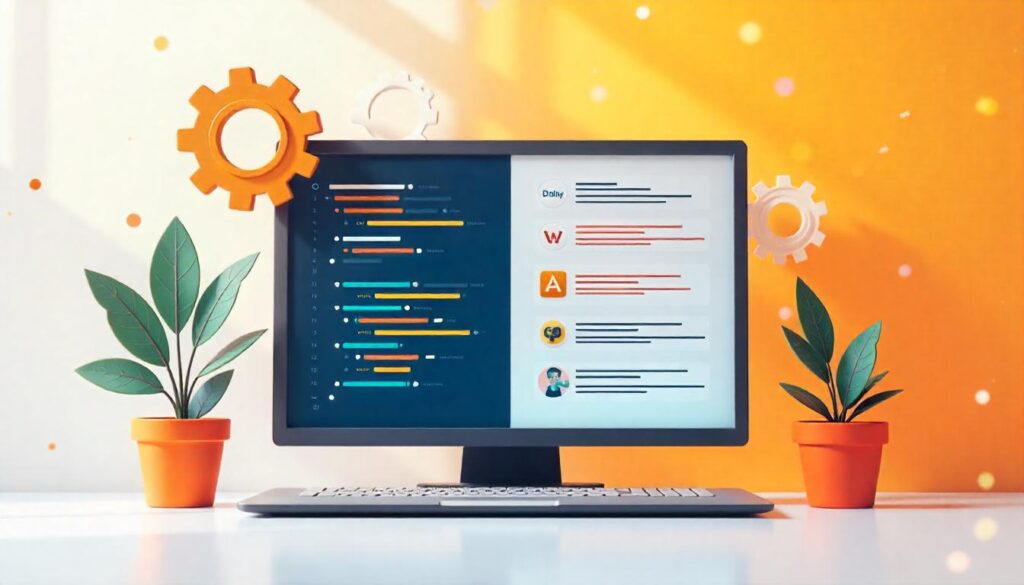
At its core, web design is about how a website looks, feels, and works for the person using it. It’s not just about making things look “pretty” (though that’s a part of it!). It’s about crafting digital experiences that are intuitive, easy for everyone to use, and genuinely engaging.
A good web designer truly understands:
- Visuals: Think about the layout, the perfect color scheme, and the right fonts to make information easy on the eyes.
- User Experience (UX) and User Interface (UI): This is about making sure the website is super easy and enjoyable to navigate. UX is the overall feel, while UI is about the specific buttons, menus, and visual elements.
- Responsiveness: Websites need to look good and work flawlessly whether someone’s viewing them on a giant desktop screen, a tablet, or a tiny smartphone.
- Basic Code: You won’t always be a full-blown coder, but knowing some HTML (for structure), CSS (for style), and a little bit of JavaScript (for interactivity) is super helpful.
It’s a really cool job that sits right where art meets tech – it’s creative but also super practical and strategic.
Why Should You Take a Web Design Course?

No matter if you’re a complete beginner or just want to update your skills with modern tools, web design courses are fantastic for helping you:
- Get comfortable with industry-standard tools like Figma, Adobe XD, and Sketch.
- Grasp the best practices for UX/UI design, so your sites are always user-friendly.
- Get hands-on experience with HTML, CSS, and basic JavaScript – the building blocks of the web.
- Build a strong portfolio filled with projects that show off your design chops.
- Gain the confidence to work freelance, apply for exciting jobs, or even launch your very own website.
Plus, with so much work happening remotely and everything moving online, skilled web designers are more in demand than ever before. It’s a great time to jump in!
Different Kinds of Web Design Courses
Here’s a quick look at the types of courses out there, so you can see what might fit your goals and schedule:
1. Quick Online Courses (Great for Beginners!)
These are perfect if you’re just dipping your toes in or exploring if web design is for you. They often have short lessons you can do at your own pace.
- SMKGrafixCreativeStudio – Web Design with WordPress: It’s free and fantastic!
- freeCodeCamp – Responsive Web Design Certification.
- Coursera – UI/UX Design Specializations: Often from top universities or companies.
- Udemy – Web Design for Beginners: Lots of practical, real-world examples.
2. Design-Focused Courses
If you’re really into the visual side, UX/UI principles, and design thinking, these are for you.
- Interaction Design Foundation (IDF) – UX Design Courses: Very in-depth on user experience.
- Skillshare – Classes on design tools: Explore courses on specific software.
- LinkedIn Learning – Mastering Adobe XD, Figma, etc.: Great for getting proficient with the popular design software.
3. Full Programs & Bootcamps
These are usually more intense and ideal if you’re looking for a career change or want to jump into freelance work quickly. They often include mentorship and help you build a solid portfolio.
- CareerFoundry – Full Web Design Program: Comprehensive training with career support.
- Springboard – UI/UX Design Career Track: Another excellent program for career shifters.
- General Assembly – User Experience Design Bootcamp: Intensive and job-focused.
What Makes a Web Design Course Good?
When you’re checking out different courses, here are a few things to keep an eye on:
- Up-to-Date Content: The web changes fast! Make sure the course teaches current best practices and tools.
- Real-World Projects: You learn best by doing. Courses that have you build actual projects are invaluable for your learning and your portfolio.
- Feedback or Mentorship: Getting advice and critiques from experienced professionals helps you grow so much faster.
- Job Support: Some programs go the extra mile by offering career coaching, help with your resume, or even job guarantees.
- Flexible Format: Think about what works for you. Do you prefer learning on your own schedule, or do you thrive with a structured class and deadlines?
What Can You Do After Learning Web Design?
Once you’ve built up your skills and have a portfolio to show off, a whole world of opportunities opens up! You could become a:
- Web Designer: Focusing on the overall look and feel.
- UI/UX Designer: Specializing in making things user-friendly and intuitive.
- Front-End Developer: If you enjoy adding more coding to your design skills.
- Product Designer: Working on the design of entire digital products.
- Freelance Designer or Consultant: Be your own boss and work with various clients!
You could work in cool startups, creative agencies, non-profits, or even as a remote freelancer from anywhere in the world.
Final Thoughts: Design Your Own Future
Learning web design isn’t just about making pretty websites – it’s about solving problems, telling stories, and shaping how people experience the digital world. With the right course and a little bit of persistence, you can turn your creative ideas into interactive, impactful designs that make a real difference.
So, if you’ve been curious about web design, now is genuinely a fantastic time to dive in. Pick a course that feels right for you, start small, stay consistent, and most importantly, enjoy the amazing creative journey ahead!
What kind of digital projects are you most excited to create?


